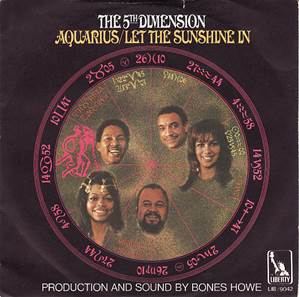[Fifty years ago this month, Tom Eagleton was elected to his first term in the Senate. I have taken that fact and somehow expanded it to a couple of Hot Stove posts – about baseball, not politics. But in the wake of this past week’s elections, I want to pause a moment to thank my friend (and occasional Hot Stove reader) Senator Claire McCaskill for her lifetime of exemplary public service. As you will read below, the Senate seat once held by Harry Truman had a 24-year run with Stuart Symington. Republicans then had a good stretch, but Claire McCaskill took back the seat in 2006. She held it for two terms. Kudos to Claire who never stopped working hard for the people of Missouri. From her first race at age 28 to her concession speech Tuesday night, a class act. Below, Claire with husband Joe (a regular Hot Stove reader) at the 2014 Cardinals home opener.]

The Washington Senators (Part 1 – Stuart Symington)
1968 was quite a year for politics and baseball. The national political scene was upended by assassinations, riots, Vietnam and the election of Richard Nixon. Baseball was blessed with a stellar World Series with Mickey Lolich outpitching the great Bob Gibson in Game 7 as the Tigers beat the Cardinals for the title.
As for major league baseball in Kansas City, 1968 was a gap year. The A’s had left for Oakland after the 1967 season and the Royals would not play ball until 1969.
1968 was also a key year for me. It was my first full year as a lawyer. And it was the year that my high school friends Jim Graham and Bill Lochman lured me into political activity with the Young Democrats. During that campaign season, I had the pleasure of meeting two United States Senators: Stuart Symington and Tom Eagleton. Symington was first elected to the Senate in 1952 and was in his third of four terms. Eagleton was a candidate for his first term and won in November.
Since this is the Hot Stove, you have likely guessed that I have baseball stories about them. I’ll cover Stuart Symington in this post and Tom Eagleton in the next.
As a general theme on Stuart Symington, I’m going to explore how he played a prominent role in assuring outstanding long-term ownership for major league baseball in both St. Louis and Kansas City.
Stuart Symington – Some Background: Stuart Symington moved to St. Louis in 1938 when he took over the presidency of Emerson Electric. Among the new friends he made was August (“Gussie”) Busch, Jr., head of the Anheuser-Busch Brewing Company. As World War II got underway, Emerson moved into defense production and Symington worked closely with Busch who had been named commandant of the Ordnance Department. The two traveled the country together checking defense production at other facilities.
In 1945, Symington left Emerson to accept a series of appointments from President Harry Truman, including a stint as the first Secretary of the Air Force (Time cover below). As Secretary, he oversaw the Berlin Airlift and set the stage for the establishment of the Air Force Academy. In 1952, he left the administration to run for (and win) a U.S. Senate seat. Not long after that, Symington was in a position to help his old friend Gussie Busch.
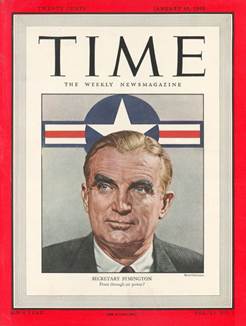
Baseball Franchises – Some Background: When the first World Series was held in 1903, there were 16 teams, eight each in the AL and NL. They were located in just 10 cities (three teams in NY; two in Boston, Chicago, St. Louis and Philadelphia; one in Pittsburgh, Washington, Detroit, Cleveland and Cincinnati). For 50 seasons, every franchise stayed in place.
And then the dam broke. In 1953, the Boston Braves moved to Milwaukee. In 1954, the St. Louis Browns moved to Baltimore. In 1955, the Philadelphia A’s moved to Kansas City. In 1958, the Dodgers and Giants moved from New York to the West Coast. In 1961, the original version of the Washington Senators moved to Minnesota. The other ten franchises remain in their original cities.
Often lost in the history of franchise relocations is that the headlines in St. Louis almost read Browns Move to L.A.! Or Cardinals Move to Houston! Or Cardinals move to Milwaukee! Or Browns Stay in St. Louis!
Browns and Cardinals: In 1892, a St. Louis team called the Browns joined the National League. In 1900, they changed the team name to the Cardinals.
When the American League was formed in 1901, one of the teams was the Milwaukee Brewers. The next season, that team moved to St. Louis, built a new stadium (Sportsman’s Park) and changed the team name to the Browns. In 1920, the Cardinals became a tenant of the Browns and played their home games at Sportsman’s Park.
Over the years, the Cardinals often had good teams. The Browns, not. As an indicator of the level of fan popularity, the attendance for the Cardinals in 1941 was 633,645; the Browns, 176,240.
But the Browns had an audacious plan to change their fortunes. They put the pieces together to move to Los Angeles for the 1942 season – 16 years before the Dodgers made that move. Investors were lined up, the Cubs minor league team and stadium (also called Wrigley) in LA would be purchased, air and train transportation was worked out, the Cardinals chipped in $250,000, and fellow AL team owners were anxious to have a strong team in a new market. The vote was expected to be unanimous at a meeting set for December 8 in Chicago. On December 7, Pearl Harbor was attacked. The plan was shelved.
The Cards won pennants in 1942, 1943 and 1944. But in a shock, the Browns won the AL pennant in 1944, somewhat aided by weak wartime rosters for other teams. It was the first and only pennant for the St. Louis Browns. The two teams met in the 1944 “Street Car” World Series with all games being played in Sportsman’s Park. The Cardinals won the Series four games to two.
In the photo below, Senator Harry Truman is shaking hands at the Series with the two managers, Billy Southworth (Cardinals) and Luke Sewell (Browns). [This photo and the two other Truman photos in this post were found in my usual Google searching, but I noted in each case that the ultimate source was our own renowned local institution, the Truman Library.]
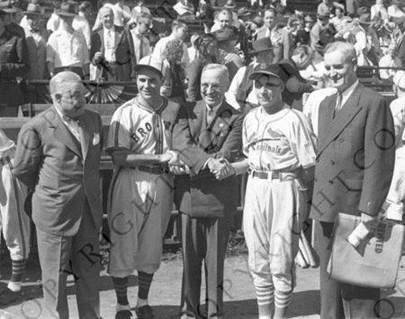
[Harry Truman Trivia: Truman was first elected to the Senate in 1934. He was reelected in 1940, and when the above 1944 photo was taken, he was running for Vice President. A month later, the Roosevelt/Truman ticket won. Six months later, Truman became President. In Truman’s famous poker games in Key West and on the presidential yacht Williamsburg, Stuart Symington was often one of Truman’s “cronies” at the table. In the 1949 photo below, Truman is standing at the poker table on the Williamsburg; then clockwise, the first two are Clark Clifford and Stuart Symington. Clifford was charged with organizing the games, replacing the naval aide who had told Truman he did not drink or play cards.]
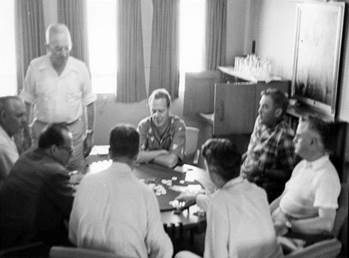
Bill Veeck, Fred Saigh and Gussie Busch: After the 1944 Series, the Browns fell back to second-division baseball. Hope came when Bill Veeck bought the team in 1951. Veeck lured fans back with ingenious promotions – the most famous being on August 19, 1951, when he sent three-foot seven-inch Eddie Gaedel to the plate. The baseball establishment was not amused. But the Browns continued to be overshadowed by the Cardinals, pushing Veeck to consider moving his team to Milwaukee or Baltimore.
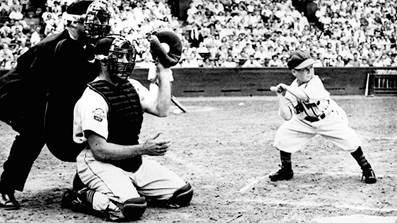
Before the 1953 season, Veeck almost got a break. Cardinals owner Fred Saigh was indicted on tax charges and put the team up for sale. The best offers came from interests in Houston and Milwaukee who wanted to move the team. This would leave Veeck with the St. Louis market to himself. But it was not to be.
Gussie Busch and his brewery stepped up to make an offer. As a civic gesture to keep the team in St. Louis, Saigh sold to Busch at a reduced price of $3.75 million. Busch was not a big baseball fan, but It was not lost on him that he would sell lots of beer to captive Cardinal fans at the stadium, as well as entice them over the airwaves by having Budweiser ads replace those of long-time sponsor Falstaff. And it was better than letting the team head to Miller and Pabst country in Milwaukee. The Braves from Boston ended up in Milwaukee.
The Busch purchase left Bill Veeck with no good options. He wanted to move the Browns to Baltimore, but the league would not cooperate with the maverick owner. So he made two sales. First, he sold Sportsman’s Park to the Cardinals. Then he sold the team to league-approved owners who were allowed to move the franchise to Baltimore. [Orioles Trivia: A team called the Baltimore Orioles was in the AL when the league was formed in 1901. The franchise moved to New York in 1903 and became the Highlanders. In 1913, the team name was changed to the Yankees.]
Senator Symington Helps an Old Friend: There was a glitch after Busch purchased the Cardinals. Senator Edwin Johnson of Colorado sponsored a bill that would make any team owned by a beer or liquor business ineligible for the antitrust exemption that was very valuable to baseball owners. Such a change would likely prompt Busch to sell the team.
Johnson argued that the purchase was just a vehicle for selling beer and that baseball would become a contest between big businesses. He said Busch was a “huckster” who regarded baseball as “a cold-blooded beer-peddling business.” Johnson had some conflicts of interest. He was the president of the Western League, a Class A minor league. The minor leagues worried about the reach of major league radio and its effect on minor league attendance. And maybe the sale of beer in Colorado. Johnson’s son-in-law owned the Denver Bears, a team that had a board member by the name of Adolph Coors.
Stuart Symington, just in his second year in the Senate, pushed back against Johnson, a 17-year veteran of the Senate. Symington argued against Johnson’s bill and heaped praise on his old friend Gussie Busch. He was aided in this endeavor by another relatively new Senator, Everett Dirksen, who had many Cardinal fans on his side of the state line in Illinois. Johnson backed down and the bill went nowhere. Anheuser-Busch got to keep its owner-friendly baseball exemption and retained ownership of the team for 43 years (from 1953 to 1996 when it was sold for $150 million).
Budweiser Stadium – Not: Gussie Busch did make one concession about beer when the company bought the team. Commissioner Ford Frick did not think any major league stadium should be named after a beer. Friends also pointed out that the Cubs played at Wrigley Field, not Doublemint Park. So Busch abandoned the idea of Budweiser Stadium – Sportsman’s Park became Busch Stadium. A year later, the company added a new product – Busch Bavarian Beer. Sorry Commissioner Frick. This Time cover of Gussie from 1955 provides a good visual of the inextricable link between baseball and beer:
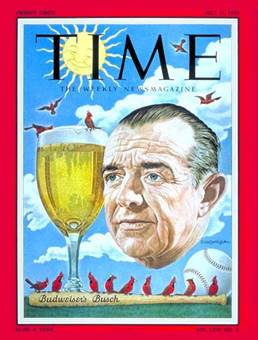
As for Ford Frick’s rule on stadium naming, times change. And money talks. The Colorado Rockies play in Coors Field. The Milwaukee Brewers play in Miller Park where the fans sing “Roll Out the Barrel” during the 7th inning stretch.
Philadelphia A’s to K.C.: After the Braves and Browns moved, the next in line was the Philadelphia Athletics move to Kansas City in 1955. Below, former president Harry Truman throws out the first pitch in the inaugural game of the A’s in Kansas City. The two managers (both future Hall of Famers) stood by – Lou Boudreau (A’s) and Bucky Harris (Tigers). Arnold Johnson, the new owner of the A’s, is standing behind Harris. [I was also at the stadium that day, in the upper deck, a 13-year –old cutting school to see the first major league game.]
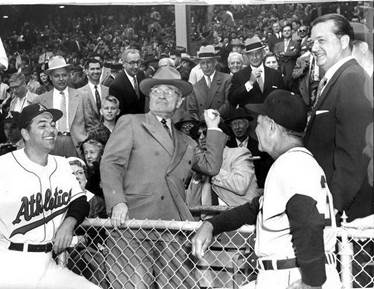
Arnold Johnson owned the A’s from 1955 to 1960. After he died in 1960, his estate sold the team to Charlie O. Finley. As remembered by many Kansas City fans, each owner had a major fault.
Johnson, soon after he bought the team, began a series of trades that sent many of the team’s best players to the Yankees.
Finley, soon after he bought the team, began a series of discussions with cities around the country for a place to move all of the team’s players.
Gussie Busch they were not.
Stuart Symington and Charlie Finley: In March of 1967, Sports Illustrated ran a cover story on “Colorful Kanas City” – not just for the green and gold uniforms, but also for the white shoes. When the A’s opened the season in April, they became the first-ever major league team to not wear black shoes. Cleveland Indians manager Joe Adcock played the game under protest, saying the shoes were distracting. Adcock lost the game and the protest.
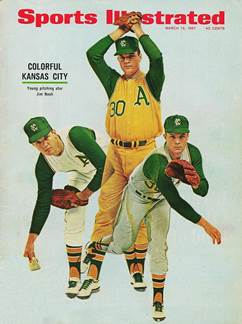
But that was only a small part of owner Charlie Finley’s plan that year. He continued his open fight with the city and screamed to be allowed to move the team. The American League, tired of the aggravation, gave in and let Finley move the A’s to Oakland in 1968.
Stuart Symington blasted Finley on the floor of the Senate, calling him a “disgrace” and saying Oakland was “the luckiest city since Hiroshima.”
Senator Symington also trained his eyes on another target – the American League.
Stuart Symington and the Royals: The American League spoke vaguely about putting an expansion team in Kansas City. No guarantee or timeline. Symington indicated that it might be time for the Senate to revisit baseball’s antitrust exemption (no doubt remembering how important it was to Gussie Busch back in 1954). The league blinked and awarded Kansas City a franchise. But they said it would not be until 1971. Not good enough said Symington. The league blinked again and moved the start date to 1969.
There were many others who helped in the process, notably sports editors Ernie Mehl and Joe McGuff of the KC Star. Also, Jackson County had passed a bond issue for a 2-stadium complex, assuring that a new team would have a state-of-the-art facility. But a big part of the leverage came from Symington, as recalled by Kansas City Mayor llus Davis, “The most distinguished persuasive and wrathful of the Kansas City delegation was Senator Stuart Symington. There can be no doubt that his presence and his active participation in Kansas City’s case to the owners caused them…to grant Kansas City an expansion team franchise…”.
Below, with Muriel and Ewing Kauffman and Mayor Davis looking on, Symington throws out the ceremonial first pitch for the Royals inaugural home opener on April 8, 1969. The following year, Symington won his fourth term for the Senate – no doubt getting a good vote margin in the KC area. [Left-Handed Trivia: Note that the Truman and Symington first pitches are both left-handed. Truman was ambidextrous and once threw two opening day pitches, one with each hand.] [Lonnie Trivia: As was the case when Truman threw out the first pitch in 1955, I was again on hand in the upper deck for the Royals first game.]

The Royals just completed their 50th season in Kansas City. A big thank you to Stuart Symington.
Symington and Wadsworth: Although I met Stuart Symington from time to time, the Symington I got to know well is his son Jim who served in the House for four terms and then lost a bid in 1976 to succeed his father in the Senate. Jim’s full name gives a hint of a political legacy – James Wadsworth Symington. Jim’s mother Evelyn was a Wadsworth. Her father was James Wadsworth, a Republican Congressman and Senator (a “wet” in the Prohibition fight; Gussie Busch would have liked him). James Wadsworth’s mother was Alice Hay, the daughter of John Hay who together with John Nicolay were the closest aides to Abraham Lincoln. In the Civil War, the Wadsworth side fought for the Union and the Symington side for the Confederacy. Ancestor Thomas Symington owned a quarry in Maryland and donated the 24,500 pound marble cornerstone that was laid in 1848 for the Washington Monument. There are many other notables in the two family chains dating back to the Continental Congress. Yes, quite a legacy. ” The notion that a pyramid would best represent the idea of George Washington. Hence, in accordance with Masonic practices, construction of the obelisk began on July 4, 1848, with a ceremonial laying of the enormous cornerstone, which had been donated by the Mason Thomas Symington who owned the quarries from which the monument’s marble was taken. The ceremony was conducted by Benjamin French, wearing the Masonic apron and sash George Washington had worn when he laid the cornerstone of the Capitol building in 1793.
Jim Symington’s Baseball Cards: It’s one of the oldest stories. It happened to me while in college. It happened to Jim Symington about the time he started high school.
I’m talking about the baseball card collection. Jim had acquired cards of some of the old stars like Babe Ruth, Lou Gehrig, Ty Cobb and Honus Wagner. He was also working on new players coming up just before the war – Ted Williams, Joe DiMaggio, Stan Musial, Peewee Reese, Phil Rizzuto, etc. As Jim lamented to me in an email, “When I came home from summer camp, they were gone! We were moving from New York to St. Louis and Mom had thrown them all away!! OUCH!”
In my case, mom said she did not know what happened to my cards. Sure.
Nonagenarian Update: Hot Stove is proud of its nonagenarian readers, and one long-time subscriber will be added to that list next Tuesday. Happy 90th birthday to my good friend Stan Bushman!
Stan is in some fine company. Two readers reside in Washington, D.C.: Jim Symington (91) and his friend Charlie Peters (91). KC attorney Bert Bates (92) campaigned with Jim Symington back in 1952. Bert was working on his father’s campaign for Missouri state treasurer and appeared at rallies, picnics and other events on behalf of his father. He often crossed paths with Jim and Tim Symington who were doing the same for their father in the Senate race. Both fathers won their elections. In 1970, Bert served as KC Chair of Stuart Symington’s last campaign. Dr. Harry Jonas (91) was the first-ever chair of the Jackson County Legislature when that new body was created under the charter in 1972. This past July, my law partner Tim O’Leary retired on his 90th birthday.
Bert Bates tells a story about a 1960 presidential campaign visit by Jack Kennedy in which he and Jim Symington participated. “We met a big group at Richards-Gebaur air base…had 20 Ford convertibles for the motorcade to downtown…hauling dignitaries…stopped at Truman Corners shopping center where Congressman Dick Bolling spoke and Jim played the guitar and sang to entertain crowd…I was in charge of the motorcade (we had an 80-motorcycle escort) and sat in front seat of lead car with a walkie-talkie directing speed/slowdown. Jim rode in front seat with me from the airbase to downtown with Kennedy, Senator Symington and Governor Dalton in back seat. Kennedy stood all of the way – had metal braces for legs so he wouldn’t be thrown out if car stopped or sped up suddenly…huge crowds lining streets along the entire route…Kennedy spoke that night at Municipal Auditorium…Great daylong event.”
Lonnie’s Jukebox: Two movies currently in the theatres offer a lot of good music. I give A Star is Born a B as a movie, but give Lady Gaga an A+ for her performance. A similar result for Bohemian Rhapsody, the biopic on Queen. Many critics have not been kind, but I say a B+, with an A+ for the last 15 minutes of Rami Malek as Freddie Mercury at the 1985 Live Aid concert. One of the songs at the concert was “Radio Gaga” – the song title that inspired Lady Gaga’s name (see the real Freddie Mercury sing this song at the concert here). For another treat at the movies, Rita and I both give an A to the mountain-climbing documentary Free Solo.
During the first two months of the Royals inaugural season in 1969, the number one song for six straight weeks was the medley “Aquarius/Let the Sunshine In” by The 5th Dimension. The two songs came from the musical Hair which opened on Broadway in 1968. Listen here. And for a surprise change of pace, click here.
